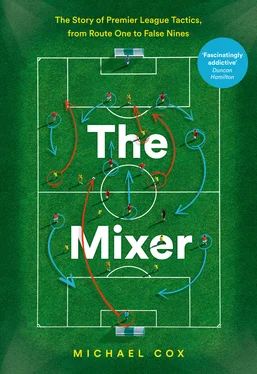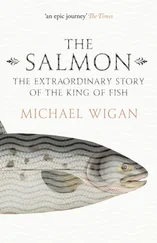‘During my time at Manchester United I was lucky enough to have a lot of people who put in countless extra hours to get better,’ Ferguson wrote in his autobiography. ‘Gary Neville turned himself from an average footballer into a wonderful one because of his work ethic, as did David Beckham. I remember Eric’s first day, and after the training session had finished he asked for a goalkeeper, two players from the junior team who were still there, and a few footballs. I asked him what he needed those for, and he said he wanted to practise. When word got back to the other players, one or two more turned up the next day for an extra session and so the number grew. That was all because of Cantona’s work ethic and influence.’ Phil Neville has a slightly different interpretation, which makes more sense considering there are plenty of tales about the incredible dedication of him, his brother and Beckham before Cantona joined. He says that Cantona didn’t inspire the youngsters to work hard – they did that already – but he made it ‘acceptable’ to do so, ensuring they weren’t seen as teacher’s pets by experienced members of the squad.
Where it counted, on the pitch, Cantona made an immediate difference. His stunning, instant impact is occasionally overlooked: he arrived at Old Trafford in late November 1992 with United in eighth place, nine points behind surprise leaders Norwich City, having scored a pitiful 17 goals in 16 league games. A title challenge was unthinkable. But with Cantona’s arrival United’s scoring rate doubled and they rose to top of the table after the first game in January.
Manchester United’s most famous victory during the title run-in was unquestionably their 2–1 victory over Sheffield Wednesday at Old Trafford, when United found themselves 1–0 down going into the final five minutes, before two headers from centre-back Steve Bruce produced an unlikely turnaround. Bruce’s second arrived deep into an unusually extended period of stoppage time – the referee had been replaced because of injury – which was the start of Manchester United’s habit of scoring crucial late goals throughout the Premier League era, and gave rise to the expression ‘Fergie time’. Ferguson and his assistant Brian Kidd famously spilled onto the Old Trafford pitch in their jubilant celebration of a winner that put Manchester United top of the table, a status they wouldn’t relinquish. However, United’s most tactically significant victory occurred five days earlier, away at Norwich. This display would dictate the big-game approach under Ferguson for years to come, and is the single most influential team performance in the history of the Premier League.
For a significant period of 1992/93, Norwich were title favourites. They’d been the first Premier League leaders after a surprise 4–2 victory over Arsenal, which appeared nothing more than a freak opening-day result, Norwich having only escaped relegation on the final day of the previous season and being widely tipped for the drop having sold star striker Robert Fleck to Chelsea. However, Norwich’s key man was actually Mike Walker, a likeable, calm, silver-haired Welshman and among the most promising managers in the country. In an era when route one remained dominant, Norwich’s passing football, their tendency to score spectacular goals and their underdog status ensured they became the neutral’s favourite. Other Premier League managers were man-managers and disciplinarians, but Walker loved discussing tactics and offered a clear, forward-thinking philosophy. He’d been dismissed from his only previous managerial job, at Colchester, because his chairman considered Walker’s brand of passing football ‘too soft’ for the lower leagues – despite the fact Colchester were only one point from the top of Division Four. Walker claimed he was ‘happy to win every match 4–3’, although Norwich actually suffered several heavy defeats and, peculiarly, finished in third place despite a goal difference of –4.
Norwich’s default formation was 4–4–2, but it was a flexible system most notable for the advanced positioning of the two full-backs, Mark Bowen and Ian Culverhouse. Right-winger Ruel Fox was among the quickest wingers in the league, central midfielder Ian Crook boasted a fine passing range and Mark Robins banged in the goals up front. They were the Premier League’s first good footballing side, and when they defeated Wimbledon 2–1 in December, their lead at the top was an incredible eight points after 18 games.
But then Norwich somehow failed to score in their next five games, almost proving the old-fashioned British dogma that continental football wasn’t suitable when winter arrived and pitches became boggy. Norwich recovered to play a significant part in the title fight, and started April top of the Premier League once again, with Aston Villa and Manchester United a point behind. The Canaries’ next fixture was a home match against Ferguson’s side, and while Villa couldn’t be ignored, this felt like a title decider. United appeared to be wobbling; winless in four matches, and without suspended centre-forward Hughes. It was widely anticipated that Ferguson would introduce veteran Bryan Robson in central midfield, with Brian McClair returning to the striking role he’d played before Cantona’s arrival.
Instead, McClair stayed in midfield alongside Paul Ince, and Ferguson deployed three natural wingers at Carrow Road, with Andrei Kanchelskis in the same team as Sharpe and Giggs, who essentially played as a centre-forward in advance of Cantona. The outcome was a quite astonishing spell of counter-attacking football, with Norwich dominating possession but United scoring on the break three times in the first 21 minutes.
The goals were incredibly direct. For the opener, Schmeichel typically hurled the ball 40 yards to Sharpe, on the left, who prodded the ball with the outside of his left foot to Cantona, waiting between the lines. The Frenchman controlled the ball, paused briefly as he waited for midfield runners, then played a through-ball that found no fewer than three United players – Sharpe, Ince and Giggs – beating Norwich’s offside trap simultaneously. Giggs collected the ball, rounded goalkeeper Bryan Gunn, could have passed, but rolled the ball home himself. From penalty box to goal in 12 seconds and eight touches.
The second featured even better interplay. Schmeichel moved to collect a loose ball inside the penalty area, but Steve Bruce thumped it to the right – straight to Kanchelskis, who volleyed the ball into the centre circle for Ince, who volleyed it back out to Giggs, who knocked the ball backwards for McClair, whose first-time pass found Kanchelskis running through on goal. The Russian winger had Cantona in support, but dribbled past Gunn and converted. From penalty box to goal again in 14 seconds and nine touches.
Just a minute later, Ince – the man supposedly anchoring the midfield behind five attackers – collected a loose ball in central midfield and immediately stormed past one, two, three challenges, bore down on Gunn and then flicked the ball right for Cantona, who fired into an empty net. This time, the move had only started from midway inside United’s half, but it took nine seconds and six touches for the ball to end up in the net.
The counter-attacking looked so simple; United simply waited for Norwich to push forward, then attacked into space with frightening speed. Each time they broke in behind with multiple players, each time they took Gunn out of the game before converting into an open goal. ‘We were a good counter-attacking side, but our performance exceeded even our own expectations,’ raved Bruce. ‘The speed and incisiveness of our movement, the quality of the passing, it was right out of the top drawer and Norwich couldn’t live with it.’
Читать дальше












